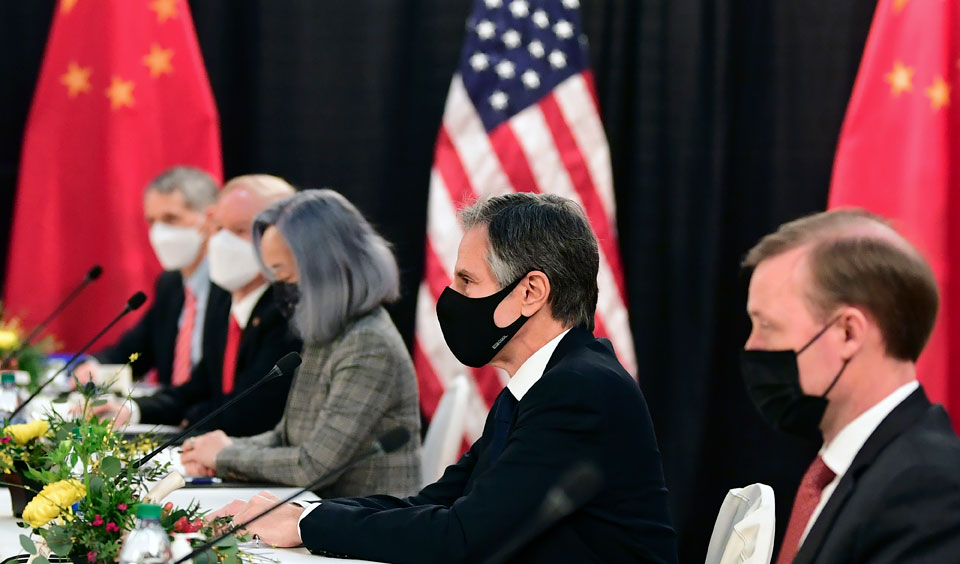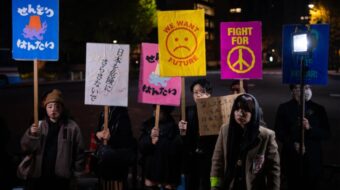
At the start of the Biden administration, the U.S. foreign policy of “American exceptionalism” so far appears to remain intact—it is imperialist, hegemonic, and anti-China. However, the new administration also recognizes certain realities that the previous White House occupant might have tried to ignore. Biden wants neither a shooting war with China nor a full decoupling of the world’s two biggest economies, and his administration’s moves show some clear departures from the approach pursued by Trump when it comes to the People’s Republic.
On March 18 and 19, high-level delegations from the U.S. and China met in Anchorage, Alaska, for discussions. Early reports suggest the meeting was overall more constructive than not. The Anchorage exchange was a resumption of the high-level leadership (re-)engagement that started almost immediately after Biden’s inauguration.
Presidents Biden and Xi Jinping first spoke on the phone in February. At that time, Xi reportedly called for expanded cooperation and improving ties; he proposed high level, in-depth dialogue between the Chinese Foreign Ministry and the U.S. State Department. Biden, in turn, articulated a series of complaints on human rights and alleged unfair economic practices. Biden also said he would pursue practical, results-oriented engagements in the interests of the U.S. and its allies. The White House characterized the relationship between the two countries as “extreme competition but not confrontation.”
The Anchorage discussions seem to have continued along similar lines. Mainstream media highlighted the adversarial exchanges—initiated by the U.S.—that characterized the beginning of the session. However, after the talks concluded, Biden Secretary of State Anthony Blinken suggested there was room for possible collaboration on climate change and some regional issues such as North Korea, Iran, and Afghanistan. There was no such possibility under his Trump administration predecessor, Mike Pompeo.
The Chinese side referred to the Anchorage talks as “frank” and “constructive” and said that the U.S. reaffirmed its commitment to the “one China principle” (seeing Taiwan as part of a single China) as well as a new joint working group on climate change. The two sides issued no joint statement at the end, however, so the practical follow up steps remain to be seen.
The U.S.’ allegations about human rights, economic coercion, and revising the international order had all been heard before, but a couple of themes prominent during the Trump/Pompeo years were apparently missing this time around; there were no attacks on China over its handling of coronavirus and no harangues about the “existential threat” of communism. China countered the complaints by defending its sovereignty and development program and called on the U.S. to stop pushing its version of democracy on other countries. The Chinese also emphasized the need for sustained strategic dialogue and pursuing mutual benefit and not confrontation. Time and circumstances will reveal how the fragile “reset” will go.
Varieties of “Containment”
U.S. policy towards China turned increasingly antagonistic after the 2008-09 economic crisis. China’s economy rebounded much better from the downturn than the U.S., causing alarm among the ruling class. The Obama administration instituted aggressive policies to “contain” and stop China, such as the “pivot to Asia” military buildup and the proposed Trans-Pacific Partnership, which was aimed at maintaining U.S. economic domination in the region. However, trade relations under Obama remained mostly normal, and there was a degree of cooperation on some international issues.
A shift came with the Trump administration. Hardliner Peter Navarro, author of the book Death by China, was a main advisor to Trump on China. At first, Trump sent positive messages to the media about his relationship with Xi Jinping, but this did not last, and a trade war was launched in 2018. U.S. national security strategy then focused on China and Russia as the two main hostile adversaries.
With the onset of the pandemic, the Trump administration became overtly hostile towards China, endlessly repeating racist and xenophobic terms like “China virus” and “kung flu.” Trump blamed his failures on managing COVID-19 on China. Racist incidents and hate crimes against Asian Americans increased. Policy was taken over by Pompeo and Navarro. The U.S. became harsher and more aggressive, risking a sharp political break, moving towards economic and cultural decoupling, and even risking military conflict. Pompeo, in an August 2020 speech, began describing China and its governing Communist Party as existential threats to the U.S. and American way of life.
What is the Biden policy? There were two possibilities when he took office: keeping the harsh, confrontational approach of Trump or shifting back to the competition/cooperation model of Obama. There seems to be no possibility of a just, democratic foreign policy. The Democratic Party platform of summer 2020 maintained the imperialist anti-China frame as its point of emphasis but also spoke of the need for cooperation on climate change and nonproliferation. The party platform says it opposed a “new cold war.” This indicates a return to the Obama period approach but with much more emphasis on competition.
The main Biden strategy is to mount a diplomatic offensive, creating an alliance to pressure and contain China. This is intended to be more effective than the go-it-alone Trump approach. This initiative got off to a poor start, though, as China recently concluded major trade agreements with Asian countries (Regional Comprehensive Economic Partnership) and the EU (Comprehensive Agreement on Investment).
Prior to the Alaska meeting last week, U.S. officials met with South Korea and Japan; Biden had a Zoom summit with the “Quad,” which includes India and Australia. While some countries on China’s borders may favor some type of containment policy towards their powerful neighbor, there is much reluctance to commit to any type of hostile, anti-China grouping. India sees itself as a rising major power and not as a U.S.-led ally. Elsewhere in the Global South, however, China’s influence continues to grow—especially as it helps countries to recover from the health and economic consequences of the pandemic.
Some people on the left are interpreting Biden’s actions as upholding the Trump/Pompeo policies. They point to the continuation of aggressive naval patrols in the South China Sea and the hawkish Biden appointments to key China policy positions. There is a consensus in Washington among Democrats and Republicans to “get tough on China,” with only a few exceptions.
For example, Blinken during his Senate confirmation hearings, readily agreed that Chinese actions among the Uyghurs were “genocide,” gaining quick approval from right-wing Republican Sen. Lindsay Graham. Secretary of Defense Austin maintains a national security stance that sees China as the U.S.’ main adversary.
There are fascistic forces who want to continue Pompeo’s aggressive bullying and threats. And the mainstream media, meanwhile, continues a daily verbal assault on China, preparing public opinion for disputes and conflict. Despite their differences on many domestic matters, substantial sections of the press, including the New York Times, are in a political bloc with the right wing when it comes to China.
New Cold War?
In the near term, it seems Biden administration policy lessens the chance of a shooting war. It is likely that there will be less quixotic, more rational decision-making in business negotiations and disputes. A large corporate sector does not want to threaten profits and markets. However, the U.S. hegemonists still have the long-term goal of helping engineer a political shift in Beijing—regime change to a counter-revolutionary, U.S.-friendly government. Without a doubt, the U.S. will continue to conduct an aggressive anti-China campaign in diplomacy, the media, global technology competition, military sales and deployment, and harsh rhetoric on questions of human rights.
During 2020, with the degeneration of U.S.-China relations in the final Trump year, there emerged in the left and progressive movements the slogan of “no (cold) war on China.” In this trend, there were different political positions taken by different organizations: whether to correctly identify the U.S. as the prime aggressor or to consider the U.S. and China having mutual responsibility for rising tension and problems.
What impact will Biden administration policies have for this emerging trend? Will anti-war activity die down now that there is a less immediate threat of U.S.-China war? But the “China scare” and prevalent anti-China rhetoric in the mainstream media will keep the “no cold war” agenda relevant.
The Biden administration will likely maintain the policy framework towards China of extreme competition with some cooperation, avoiding war. But the policy is not rooted in principle and could change quickly depending on circumstances. In any event, progressives should oppose conflict and war and support any possibility for cooperation between the two governments or among their people.
As with all op-eds published by People’s World, this article reflects the opinions of its author.









